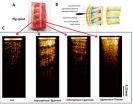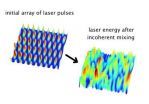(Press-News.org) WASHINGTON, May 27, 2014—The march of modern medicine is often driven by revolutions in medical imaging. When technology advances, doctors are better able to peer deeply into human tissues, and thus able to detect, diagnose and treat human diseases more effectively.
Now, researchers have taken an established imaging technology called "optical coherence tomography," or OCT, and integrated it with other instruments to bring about the next revolution in imaging by helping doctors provide safer, less painful and more effective care for women in labor and people with diabetic retinopathy and glaucoma. Their research will be presented at CLEO: 2014 being held June 8-13 in San Jose, California, USA.
OCT uses scattered "echoes" or reflections of light waves to produce high-resolution images of biological tissues, similar to ultrasound imaging but with one order of magnitude improvement in the resolution. Ophthalmologists have been using OCT to examine the retina for years. More recently, OCT has been applied to a number of other clinical specialties, including oncology for early cancer detection and staging in the gastrointestinal and urogenital tract as well as in cardiology, where it is used to study the formation of plaques in coronary arteries in situ.
Precision-guided epidurals
Bioengineer Yu Chen of the University of Maryland and his colleagues have developed a way to integrate an OCT device with an 18-gauge epidural needle. Epidural administration, Chen notes, is traditionally done blindly, using anatomical landmarks. But the team's newly miniaturized handheld device lets anesthesiologists see tissue from the perspective of the tip of the epidural needle, which could help doctors to deliver spinal anesthetic to patients with less pain and fewer complications.
"Due to lack of visual feedback, failure rates are often high, leading to multiple needle insertions," he says. Side effects of these failures can include trauma to blood vessels and punctures in the dura, the outermost membrane surrounding the brain and spinal cord.
"An OCT forward-imaging probe can provide anesthesiologists with real-time visualization of the microarchitecture of tissues and important landmarks, and thus could significantly improve the accuracy and the safety of the needle-based procedure," Chen says.
The researchers have been successful in testing needle-guidance experiments on pig swine samples and hope to conduct a pre-clinical study of the device within the next year.
Presentation AM2O.3, titled "Real-time Epidural Anesthesia Guidance Using Optical Coherence Tomography Needle Probe will take place Monday, June 9, at 11:15 a.m. in Salon V & VI of the San Jose Convention Marriott.
Better blood monitors
A team at the University of California, Davis, led by Biomedical Engineer Vivek Srinivasan has shown how OCT can simultaneously measure blood flow and blood oxygenation in vessels, without the need for contrast agents.
Like ultrasound, OCT can provide structural information, but it can also be used to determine flow rates and for angiography, visualizing the interior of blood vessels, says Shau Poh Chong, a postdoctoral researcher in the Srinivasan lab.
"Conventional pulse oximetry measures oxygen saturation using transmitted light," Chong says. "Performing these measurements quantitatively with reflected light has traditionally been difficult due to the unknown distance traveled by the light through scattering tissue."
OCT directly determines the distance that light travels. Until now, however, it was difficult to use OCT to measure oxygen saturation in blood, due to additional modeling errors introduced by light scattering. At visible wavelengths, scattering is much lower relative to blood absorption than at infrared wavelengths, where OCT is typically performed. The OCT system developed in the Srinivasan lab uses broadband visible light to measure the amounts of both oxygenated and deoxygenated hemoglobin, the oxygen-carrying protein of blood, thus revealing oxygen saturation levels. In addition, the team developed new methods to further reduce modeling errors caused by light scattering.
"The broad set of measurements provided by the system, including angiography, oximetry and red blood cell flow rates enables the direct assessment of tissue oxygen metabolism, which is essential for understanding the evolution of oxygen supply and demand in numerous disease models," Chong says. "In the future, these techniques could be applied to study metabolic changes in diseases that affect the human retina, such as diabetic retinopathy and glaucoma."
Presentation ATh1O.2, titled "Optical Coherence Imaging of Microvascular Oxygenation and Hemodynamics will take place Thursday, June 12, at 8:30 a.m. in Willow Glen I - III of the San Jose Convention Marriott.
INFORMATION:
PRESS REGISTRATION: A press room for credentialed press and analysts will be located in the San Jose Convention Center, Sunday through Thursday, June 8-12. Those interested in obtaining a press badge for CLEO: 2014 should contact Lyndsay Meyer at 202.416.1435 or lmeyer@osa.org.
About CLEO
With a distinguished history as the industry's leading event on laser science, the Conference on Lasers and Electro-Optics (CLEO) is the premier international forum for scientific and technical optics, uniting the fields of lasers and opto-electronics by bringing together all aspects of laser technology, from basic research to industry applications. CLEO: Expo showcases the latest products and applications from more than 300 participating companies from around the world, providing hands-on demonstrations of the latest market innovations and applications. The Expo also offers valuable on-floor programming, including Market Focus and the Technology Transfer program.
Sponsored by the American Physical Society's (APS) Laser Science Division, IEEE Photonics Society and The Optical Society (OSA), CLEO provides the full range of critical developments in the field, showcasing the most significant milestones from laboratory to marketplace. With an unparalleled breadth and depth of coverage, CLEO connects all of the critical vertical markets in lasers and electro-optics. For more information, visit http://www.cleoconference.org. CLEO: 2014 takes place June 8 - 13 at the San Jose Convention Center.
Precision-guided epidurals and better blood monitors
New applications for OCT could improve care for women in labor and people with diabetic retinopathy and glaucoma
2014-05-27
ELSE PRESS RELEASES FROM THIS DATE:
Update on Funny River Fire, southern Alaska
2014-05-27
NASA's Terra satellite passed over the central Alaska and the Moderate Resolution Imaging Spectroradiometer (MODIS) instrument that flies aboard captured an image of smoke and hot spots from the Funny River Fire in southern Alaska on May 26 at 21:45 UTC (5:45 p.m. EDT). The heat from the fire appears red in the imagery and the smoke appears light brown.
On May 26 at 9:30 a.m. local time, the Alaska Interagency Incident Management Type 2 Team reported on the status of the fire through the multi-agency Incident Information System known as Inciweb. At that time the fire ...
More access to health care may lead to unnecessary mammograms
2014-05-27
GALVESTON —Researchers have concluded that providing better access to health care may lead to the overuse of mammograms for women who regularly see a primary care physician and who have a limited life expectancy.
The cautionary note from researchers at the University of Texas Medical Branch at Galveston is that screening women in this category could subject them "to greater risks of physical, emotional and economic suffering."
Dr. Alai Tan, a senior biostatistician in UTMB's Sealy Center on Aging and lead author of the study, said that "there has been little systematic ...
Smaller accelerators for particle physics?
2014-05-27
WASHINGTON D.C., May 27, 2014 -- It took every inch of the Large Hadron Collider's 17-mile length to accelerate particles to energies high enough to discover the Higgs boson. Now, imagine an accelerator that could do the same thing in, say, the length of a football field. Or less.
That is the promise of laser-plasma accelerators, which use lasers instead of high-power radio-frequency waves to energize electrons in very short distances. Scientists have grappled with building these devices for two decades, and a new theoretical study predicts that this may be easier than ...
New epilepsy treatment offers 'on demand' seizure suppression
2014-05-27
A new treatment for drug-resistant epilepsy with the potential to suppress seizures 'on demand' with a pill, similar to how you might take painkillers when you feel a headache coming on, has been developed by UCL (University College London) researchers funded by the Wellcome Trust.
The treatment, described in Nature Communications, combines genetic and chemical approaches to suppress seizures without disrupting normal brain function. The technique was demonstrated in rodents but in future we could see people controlling seizures on-demand with a simple pill.
Epilepsy ...
Light-colored butterflies and dragonflies thriving as European climate warms
2014-05-27
Butterflies and dragonflies with lighter colours are out-competing darker-coloured insects in the face of climate change.
In a new study published in Nature Communications, scientists from Imperial College London, Philipps-University Marburg and University of Copenhagen have shown that as the climate warms across Europe, communities of butterflies and dragonflies consist of more lighter coloured species. Darker coloured species are retreating northwards to cooler areas, but lighter coloured species are also moving their geographical range north as Europe gets warmer.
For ...
Climate warming favors light-colored insects in Europe
2014-05-27
Climate changeButterflies and dragonflies with a lighter shade of colour do better in warmer areas of Europe. This gives them a competitive advantage over the darker insects in the face of climate change. Changes in Europe's insect assemblages due to warming can already be seen for dragonflies, shows a study recently published in Nature Communications.
"When studying biodiversity, we lack general rules about why certain species occur where they do. With this research we've been able to show that butterfly and dragonfly species across Europe are distributed according to ...
Why are girl babies winning in the battle for survival?
2014-05-27
Sexual inequality between boys and girls starts as early as in the mother's womb – but how and why this occurs could be a key to preventing higher rates of preterm birth, stillbirth and neonatal death among boys.
A team from the University of Adelaide's Robinson Research Institute has been studying the underlying genetic and developmental reasons why male babies generally have worse outcomes than females, with significantly increased rates of pregnancy complications and poor health outcomes for males.
The results - published today in the journal Molecular Human Reproduction ...
Medical mechanics
2014-05-27
Removing a malignant tumor from the head of the pancreas is a risky and demanding operation. The surgeon must carefully navigate around the stomach, the gallbladder, the bile duct, lymph nodes, and several high-pressure blood vessels.
But an inexpensive device designed by Harvard engineering students and a surgeon at Beth Israel Deaconess Medical Center offers surgeons a confident grip throughout the delicate procedure. The gentle grasper, equipped with rubberized pressure sensors, has three slender fingers that can slip through a very small incision and tease cancerous ...
Just look, but don't touch: EMA terms of use for clinical study data are impracticable
2014-05-27
The European Medicines Agency (EMA) receives comprehensive clinical study data from drug manufacturers. These data form the basis for the decision on the approval of new drugs. To make this information available to researchers and decision-makers, EMA issued a draft policy in 2013 for the publication of clinical study data, in which extensive data transparency was planned.
Besides other interested parties, the German Institute for Quality and Efficiency in Health Care (IQWiG) was intensely involved in the subsequent consultations. The result of these consultations is ...
The future of sweet cherry in Australia
2014-05-27
AUSTRALIA -- Predicted variations in global climates have fruit producers trying to determine which crops are best suited to weathering future temperature changes. Extreme high-temperature events are expected to become more frequent, and predictive models suggest that the global mean surface air temperature will rise by as much as two degrees by the middle of the 21st century. Higher temperatures could have an impact on the duration of critical "winter chill" periods needed for successful fruit production, potentially altering growing strategies. According to the authors ...
LAST 30 PRESS RELEASES:
Making lighter work of calculating fluid and heat flow
Normalizing blood sugar can halve heart attack risk
Lowering blood sugar cuts heart attack risk in people with prediabetes
Study links genetic variants to risk of blinding eye disease in premature infants
Non-opioid ‘pain sponge’ therapy halts cartilage degeneration and relieves chronic pain
AI can pick up cultural values by mimicking how kids learn
China’s ecological redlines offer fast track to 30 x 30 global conservation goal
Invisible indoor threats: emerging household contaminants and their growing risks to human health
Adding antibody treatment to chemo boosts outcomes for children with rare cancer
Germline pathogenic variants among women without a history of breast cancer
Tanning beds triple melanoma risk, potentially causing broad DNA damage
Unique bond identified as key to viral infection speed
Indoor tanning makes youthful skin much older on a genetic level
Mouse model sheds new light on the causes and potential solutions to human GI problems linked to muscular dystrophy
The Journal of Nuclear Medicine ahead-of-print tip sheet: December 12, 2025
Smarter tools for peering into the microscopic world
Applications open for funding to conduct research in the Kinsey Institute archives
Global measure underestimates the severity of food insecurity
Child survivors of critical illness are missing out on timely follow up care
Risk-based vs annual breast cancer screening / the WISDOM randomized clinical trial
University of Toronto launches Electric Vehicle Innovation Ontario to accelerate advanced EV technologies and build Canada’s innovation advantage
Early relapse predicts poor outcomes in aggressive blood cancer
American College of Lifestyle Medicine applauds two CMS models aligned with lifestyle medicine practice and reimbursement
Clinical trial finds cannabis use not a barrier to quitting nicotine vaping
Supplemental nutrition assistance program policies and food insecurity
Switching immune cells to “night mode” could limit damage after a heart attack, study suggests
URI-based Global RIghts Project report spotlights continued troubling trends in worldwide inhumane treatment
Neutrophils are less aggressive at night, explaining why nighttime heart attacks cause less damage than daytime events
Menopausal hormone therapy may not pose breast cancer risk for women with BRCA mutations
Mobile health tool may improve quality of life for adolescent and young adult breast cancer survivors
[Press-News.org] Precision-guided epidurals and better blood monitorsNew applications for OCT could improve care for women in labor and people with diabetic retinopathy and glaucoma




